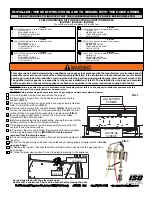
Services Menu
WILINK I MODULAR BASE STATION SYSTEM MANUAL
127
4.10
Services Menu
4.10.1
Introduction to Services
4.10.1.1
Services, Subscribers and Service Profiles
A Service is a virtual connection between a Subscriber’s application and the
Network Resource. The Network Resource could be Internet, Content Provider,
Corporate Network, etc.
The Services are implemented as IEEE 802.16 connections within the wireless
domain. Each Service can include up to 4 uplink and 4 downlink connections.
Implementation within the provider’s backbone domain depends on the specific
backbone network.
A Subscriber is an entity that may be associated with any number of devices
connected to any number of SUs. Each Service associates a certain Service Profile
with Subscriber’s device(s) behind a specific SU.
The Service Profile’s properties depend on the Service Type. All data Services have
the following properties:
VLAN ID based Classification: Each Service can be associated with up to 16
VLAN IDs, enabling creation of VLANs within the wireless domain and
differentiation of services to different end-users behind the same SU based on
VLAN ID classification.
Quality of Service (QoS) and Priority based Classification: Up to 4 uplink and
4 downlink QoS profiles can be assigned to each Service. The data will be
mapped onto these connections by either IEEE 802.1p or DSCP priority tags.
This will lead to creation of the corresponding number of Uplink and
Downlink connections supporting differentiated services to up to 4
applications based on either IEEE 802.1p or DSCP prioritization schemes. In
cases where prioritization is not used, a single pair of uplink/downlink
connections is created.
Forwarding Rules: A Forwarding Rule is assigned to each Service, defining
various features that define the handling of certain message types in the
wireless domain. These may include Unicast and Multicast Forwarding rules,
QoS Profile for Multicasts and Unknown Address Forwarding Policy. The
available features depend on the Service Type. The data may be switched only
between the Services that share the same Forwarding Rule. In all other
respects the service functions as a standard Bridge.
















































